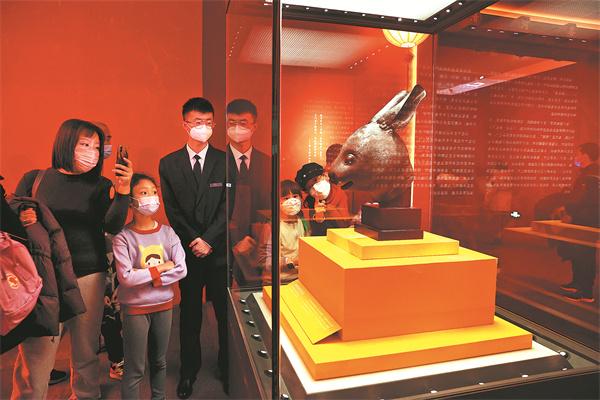It's a bunny old world
 0 Comment(s)
0 Comment(s) Print
Print E-mail China Daily, February 21, 2023
E-mail China Daily, February 21, 2023

Visitors appreciate a bronze rabbit head, formally one of the 12 zodiac animal statues that served as part of a water-clock fountain in Yuanmingyuan, the Old Summer Palace, that is on show.[Photo provided by Jiang Dong/China Daily]
Exhibition of ancient rabbit-themed artifacts at the National Museum of China highlights crucial role that the animal has played in culture.
The rabbit is an endearing animal. Its cute, vulnerable look is in sharp contrast to its intellect, agility and dexterity. It features prominently in art and culture, and the most famous examples in the Western world include the White Rabbit, a character from Alice's Adventures in Wonderland, the children's book written by British author Lewis Carroll in the 19th century, and Peter Rabbit, the mischievous protagonist of British author Beatrix Potter's illustrated work.
In Chinese culture, the most famous rabbit is Yutu, or Jade Rabbit, the faithful companion of Chang'e, the moon goddess.
Moreover, it is tasked with a mission, ordered by the Emperor of Heaven, to help prepare the medicine of immortality; as a result, Jade Rabbit is often depicted as busily pounding elixir ingredients with a pestle and mortar under an osmanthus tree.
The tale has been passed down through generations, and it seemed natural for China to name its first lunar rover after this mythological figure.
The rich cultural meanings and the goodwill that the ancient Chinese embedded in the rabbit are on show at the latest installment of the National Museum of China's annual Chinese New Year Exhibition.
The exhibition, launched in January, is being held until March. It highlights more than 80 artifacts that depict the rabbit's multiple roles, from a subject of worship for its fertility, as a synonym for the moon, as a herald of a ruler-to-be blessed with wisdom and good virtue, to a symbol of longevity, prosperity and happiness.
On show are objects made of jade, ceramic and bronze, as well as paintings and calligraphy, dated from the Shang Dynasty (c. 16th century-11th century BC) to the modern day.
A jade pendant from the Ming Dynasty (1368-1644) shows two standing jade rabbits jointly holding a pestle while in the middle of grinding ingredients of the elixir. This piece of fine craftsmanship reflects the rabbit as a recurring motif of Ming jade art and the preference for a symmetry in Chinese aesthetics, according to Gao Xiuqing, a researcher at the National Museum of China and the exhibition's curator.
Also on show is another jade pendant, also from the Ming Dynasty, which depicts a rabbit turning its head to sniff and bite a flower, with its long ears pricked upward and one foot lifted to add a sense of vitality to the work.
Gao says a Ming jade cup on show, with two rabbit-shaped handles, epitomizes the jade carving techniques of the time. "The rabbit handles, again, favor a symmetrical design, and upon closer examination, the details on the cup feature delicate patterns of clouds and lingzhi (a fungus native to East Asia) that accentuate a sense of vigor."
She adds that the cup is an example of the Ming Dynasty's "hollow engraving" art that originated in the Song Dynasty (960-1279). The craft demanded that artisans pierced deep into the jade to carve intricate landscapes, figures, animals and other patterns.
"And the style of the cup is believed to have evolved from 'yu (feathers) shang (cup)', a unique wine cup with two expansive handles like that of a bird's wings," she says. "For example, one such cup was mentioned in Lantingji Xu (Preface to the Collection of Poems of the Orchid Pavilion), a piece of prose by the fourth-century calligrapher Wang Xizhi."
Another highlight at the exhibition is a bronze rabbit head, formally one of the 12 zodiac animal statues, which served as heads of a water-clock fountain at Yuanmingyuan, the Old Summer Palace. It was looted during the Second Opium War (1856-60) and transported abroad, before being returned in 2013.
The exhibition also includes artifacts that do not feature rabbits, but were made to enhance the festive, auspicious atmosphere of the Lunar New Year, or to hail the beauty of winter landscapes and welcome the arrival of spring.
Gao says that intellectuals and artists decorated their living space with works of art that were in accordance with the changes of season; for example they hung paintings which depict snow scenes, barren mountains, blooming plum trees and magpies. It brought a tranquil, peaceful mood to people's homes, through which they hoped to pacify their souls and nurture their minds.






Go to Forum >>0 Comment(s)